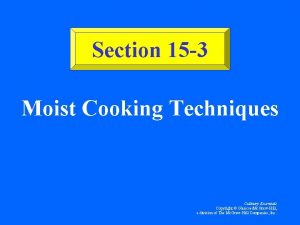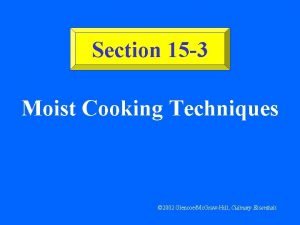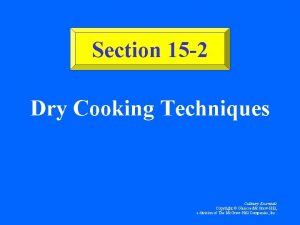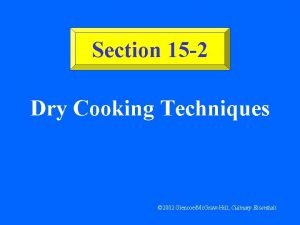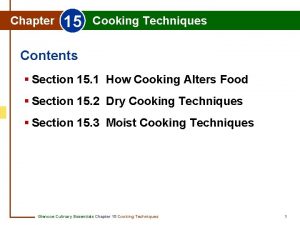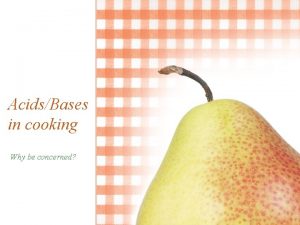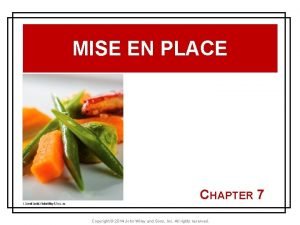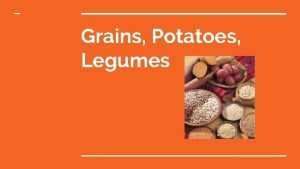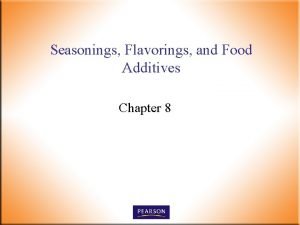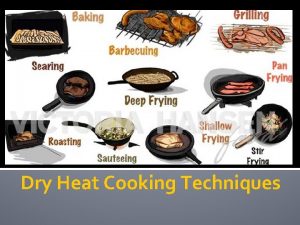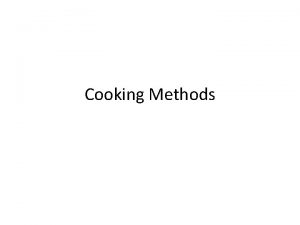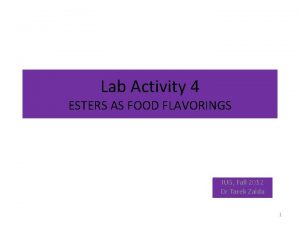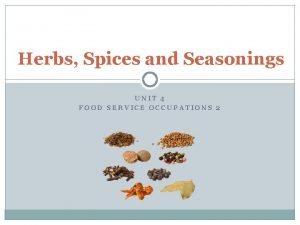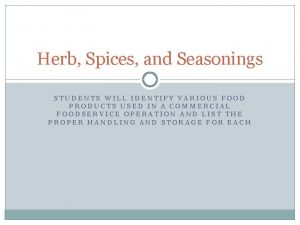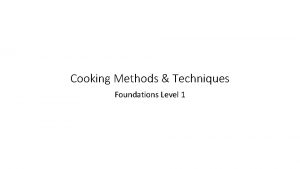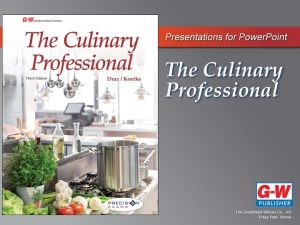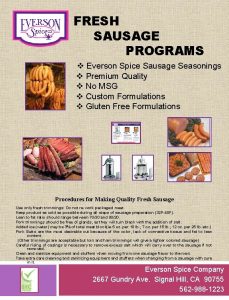Cooking Techniques Seasonings and Flavorings Cooking Cooking is
















- Slides: 16

Cooking Techniques, Seasonings and Flavorings

Cooking • Cooking is the transfer of energy from a heat source to food. Cooking affects nutritional value, texture, color, aroma and flavor.

Dry Heat • Applies heat directly with flame or indirectly by surrounding food with heated air or fat. • Techniques include: • • Baking Grilling – heat below Broiling – heat above Roasting Sautéing/Stir-Frying Pan Frying Deep Frying

Moist Heat • Applies heat to food by submerging it directly in hot liquid or steam. Can tenderize less tender foods. Flavor and nutrients can be lost when moist heat is used. • Techniques include: • • • Poaching 160 -180 Simmering 185 -205 Boiling 212 Steaming 212 or higher Blanching – boiled for a short time to partially cook food • *Adjust temperatures for altitude

Combination • First step is to brown the food using a dry heat method. The second step is to complete cooking by simmering the food in a liquid. • Use for less tender cuts of meat, poultry and vegetables. • Creates a richness in the flavor. • Techniques include: • Braising – large pieces of food • Stewing – small pieces of food

Flavor • Flavor can be defined as the sensory properties of food. These are perceived with taste, aroma, temperature, appearance and texture. • Tastes: sweet, sour, salty, bitter • Chinese include hot/spicy as a fifth taste • Umami (from Japan) has recently been accepted by western cultures as a 5 th taste - savory

Seasoning • Ingredients that enhance the flavor of food without changing the natural flavor. • Salt is the most basic and most commonly used seasoning. • Monosodium Glutamate (MSG) – comes from seaweed, intensifies the natural flavor of most foods it’s added to. (No effect on milk or fruit)

Flavoring • An item that adds a new taste to food and/or alters its’ natural flavors.

Herbs • The leaves, stems and flowers of aromatic plants. • Available fresh and dry. • When using dry, use half as much as fresh. • Fresh herbs are added at the end of cooking • Dried herbs are added at the beginning of cooking • Store dried in airtight containers away from heat and light • Store fresh herbs in the refrigerator

Spices • • Bark, buds, fruit, roots, seeds or berries Usually in dry form, available whole or ground. Store in airtight container and avoid light Pepper is the most common spice used

Vinegars • Thin, sour, acidic liquid that can be used to add flavor during cooking or as a condiment • Vinegar was alcohol • Vinegar is often named for the ingredient it is made from • • Wine vinegars were made from wine Cider vinegar from apple cider (alcohol type) Rice wine vinegar from rice wine Balsamic is from grapes (wine) reduced and aged in wooden barrels 4 -50 years high acid level, but sweet

Condiments • Sauces that are served as an accompaniment to foods. May be used to alter or enhance flavor • Common condiments • • Ketchup Mustard Salsa Soy Sauce BBQ Sauce Hot Sauce Pickled Foods

Extracts • Concentrated flavors most often used in baking. • Vanilla, lemon, almond, etc.

Onions • Includes • • • Scallions Leeks Shallots Chives Garlic

Lemons • Use only the zest or juice • Use fresh when ever possible

Nuts • Adds flavor, texture and color
 Section 15-3 moist cooking techniques
Section 15-3 moist cooking techniques Cooking food in a liquid between 150-185 f
Cooking food in a liquid between 150-185 f Section 15-2 dry cooking techniques
Section 15-2 dry cooking techniques Crosshatch markings culinary
Crosshatch markings culinary Ways of cooking food
Ways of cooking food Cooking food uncovered without added liquid or fat
Cooking food uncovered without added liquid or fat Wet cooking methods
Wet cooking methods Dry heat method
Dry heat method Fonction technique scooter
Fonction technique scooter Importance of cooking
Importance of cooking Auxiliary equipment in kitchen examples
Auxiliary equipment in kitchen examples Eating together class 4 evs chapter
Eating together class 4 evs chapter Acids and bases in cooking
Acids and bases in cooking Auxillary cooking equipment
Auxillary cooking equipment Preliminary cooking and flavoring
Preliminary cooking and flavoring Cooking pasta and rice activity 2 chapter 30
Cooking pasta and rice activity 2 chapter 30 Questioning strategies to engage all learners
Questioning strategies to engage all learners
